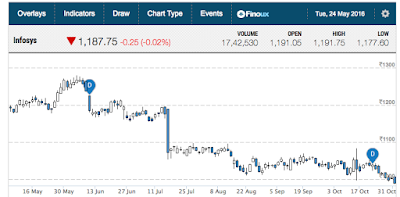Fundamental Analysis:
 |
| Picture Depicts the Concept of Fundamental Analysis |
Fundamental analysis is a thorough analysis of company carried
out with the intention of buying the shares for long-term investment. It is
based on studying the profitability of the operations, assets and liabilities
position, cash flows, etc., going as far back into the past as possible. During
the process a number of important ratios as under are derived and used:
- Profitability Ratios: EBDITA, EBT, PBT and PAT margins.
- Liquidity Ratios: Current and Quick Ratios.
- Long term Leverage Ratios: Debt-Equity and TOL/ TNW.
- Market Conditions: PE Ratio, Price to Book Value, Dividend Yield, Distance fro 52 week-low. Five-Year Returns.
 |
| Picture Shows Fundamentals of Infosy Share |
Technical Analysis:
Technical Analysis is the charting the price movements and
attempting to interpret short-term market behaviour of stock with intention of
making a profit from trading in stocks, commodities and currencies and their
derivatives.
 |
| Candle Stick Chart of Infosys Ltd. Share from May to October 2016 |
Differences between Fundamental and Technical Analysis:
|
Differences Between Fundamental and
Technical Analysis
|
||
|
Sl. No.
|
Fundamental Analysis
|
Technical Analysis
|
|
1
|
Rational Science
|
Pseudo Science
|
|
2
|
Current Market Price is one of the inputs
|
Market prices and their movements is the only input –
facts relating company’s performance are not relevant
|
|
3
|
Used for evaluating fitness of stocks for long term
investment
|
Used for taking short terms positions
|
|
4
|
Does not involve market prediction
|
Prediction of future market behavior is the sole purpose
of technical analysis
|
|
5
|
Used by investors
|
Used by day traders and margin traders
|
|
6
|
Primarily intended for taking delivery of scrips
|
Not intended for taking delivery – trades are primarily
meant to be squared-off within the same day or by the end of the contract
period
|
|
7
|
Only relates physical shares
|
Primarily relates derivatives like futures and options but
also involves physical shares in the intra-day trading
|
Conclusion:
While fundamental analysis is an exacting and rational
discipline, technical analysis is a false study endeavouring to derive
legitimacy from the use of charts and graphs and the lofty sounding name.
Whatever realisation of predictions may be owing to the innumerable
practitioners acting according to the interpretation of the pattern and not
directly caused by the pattern – something akin to divination of future
employed in the ancient times.



